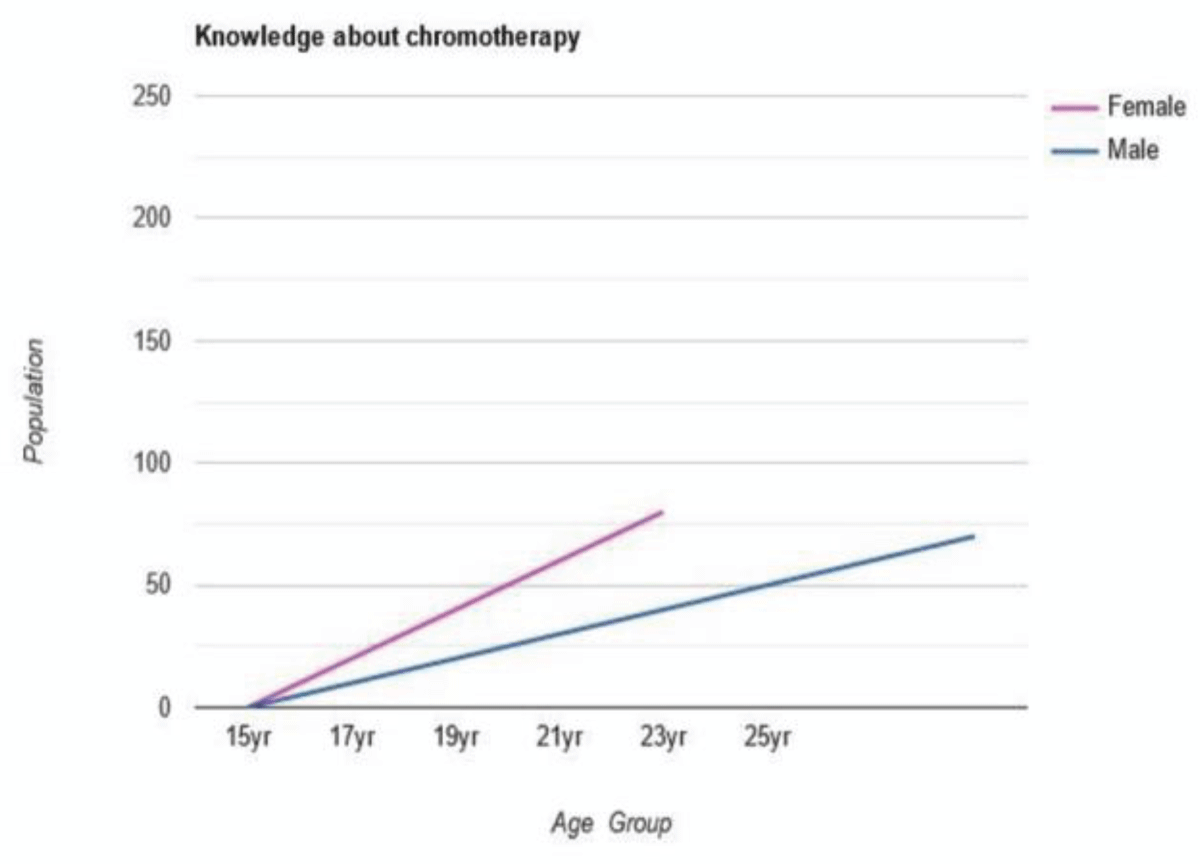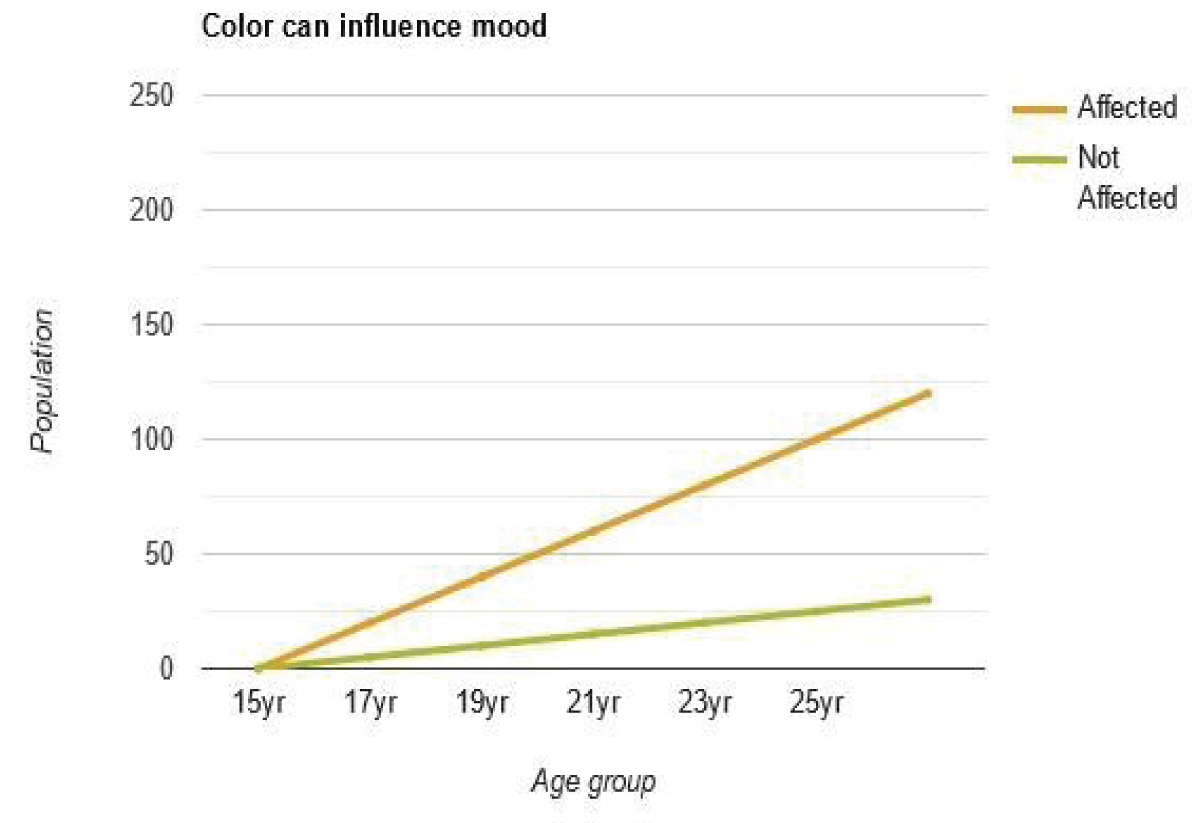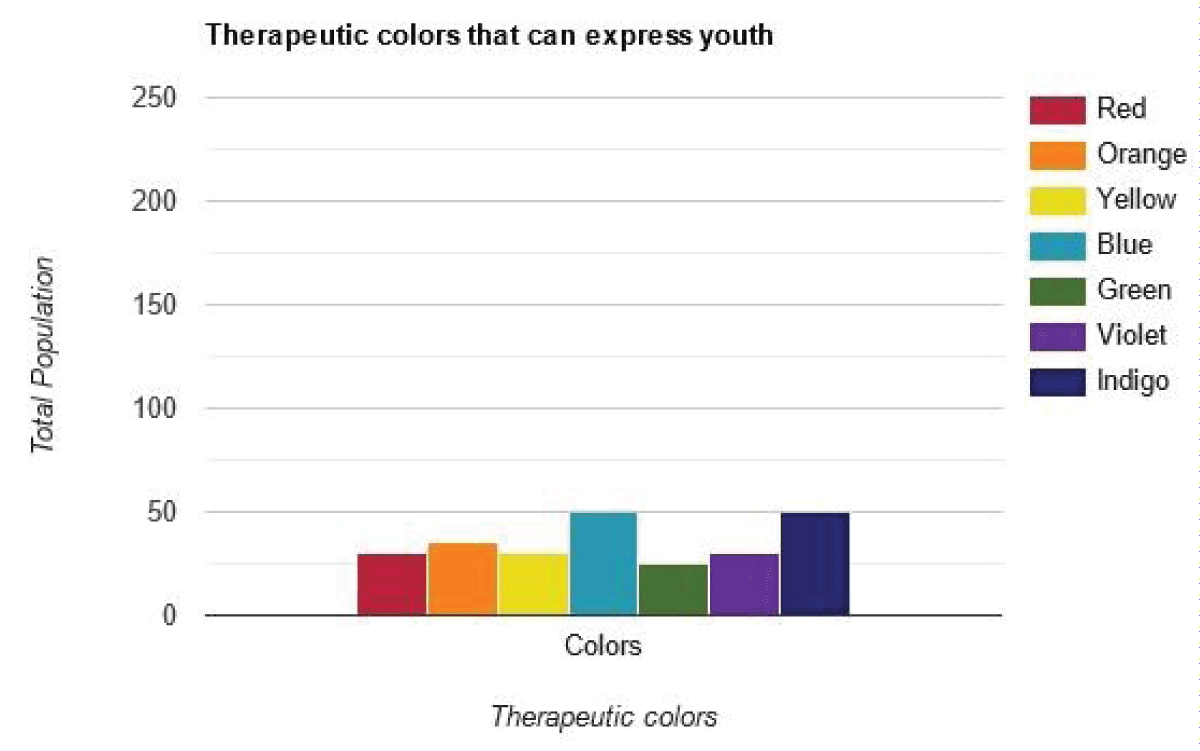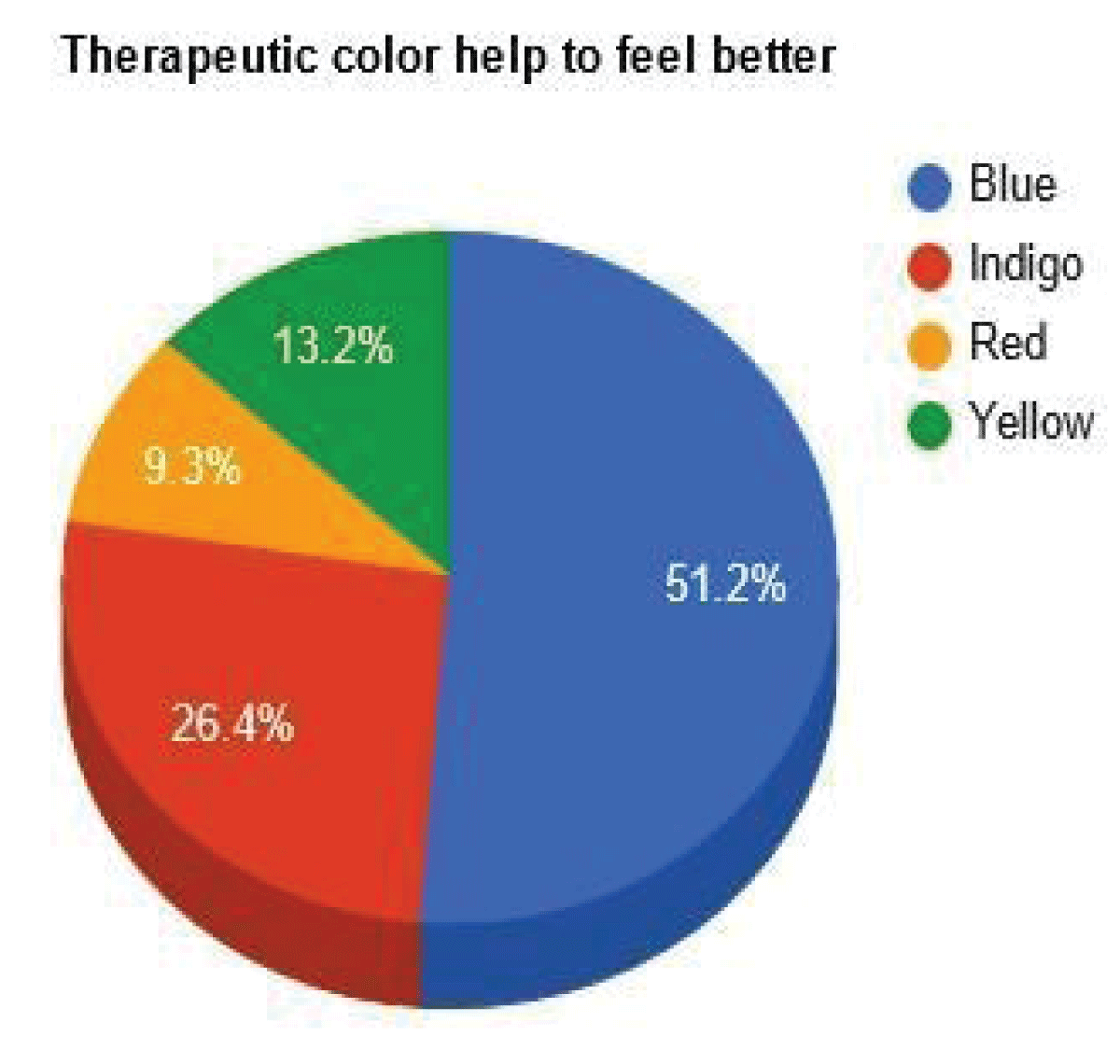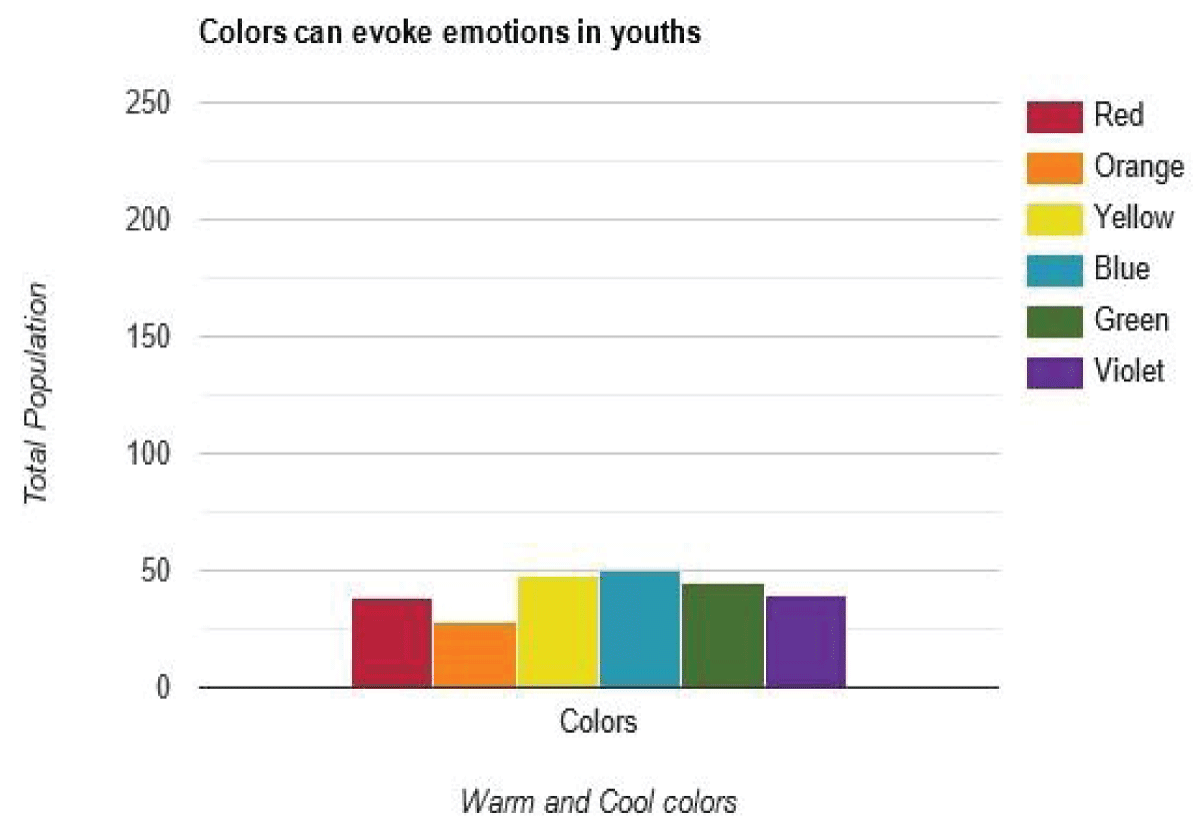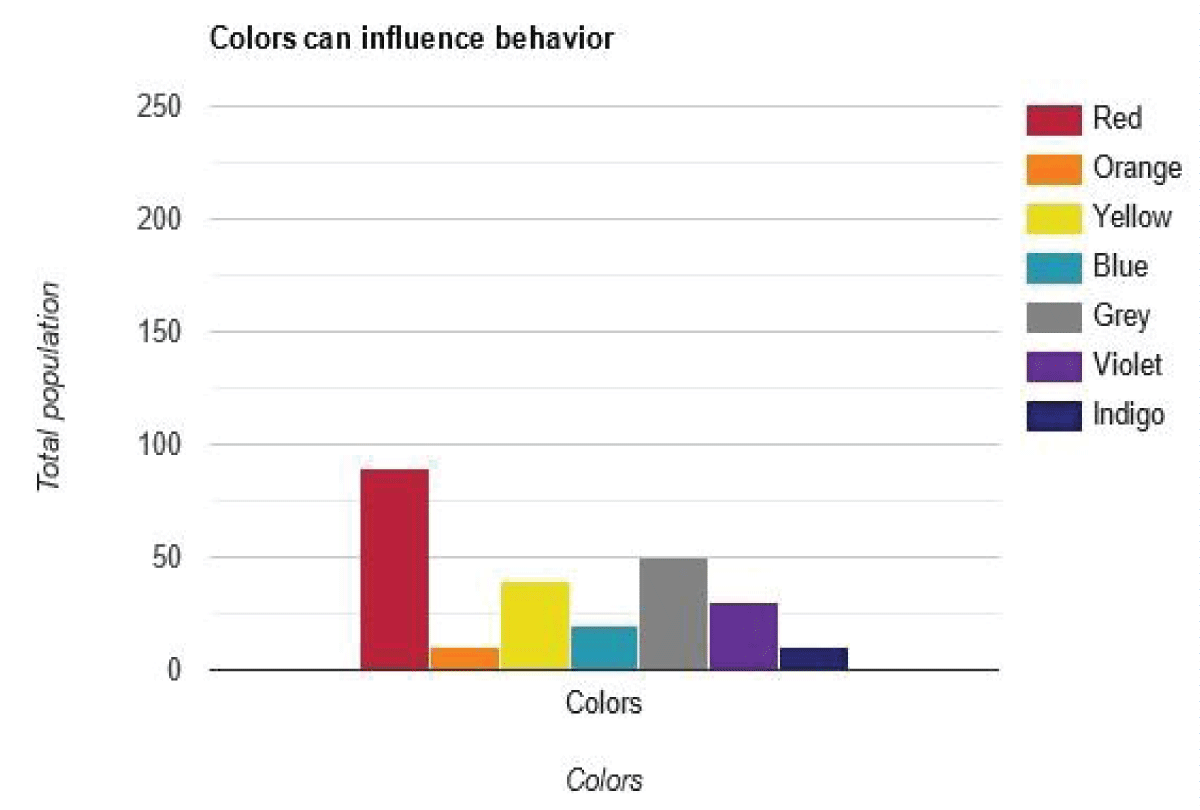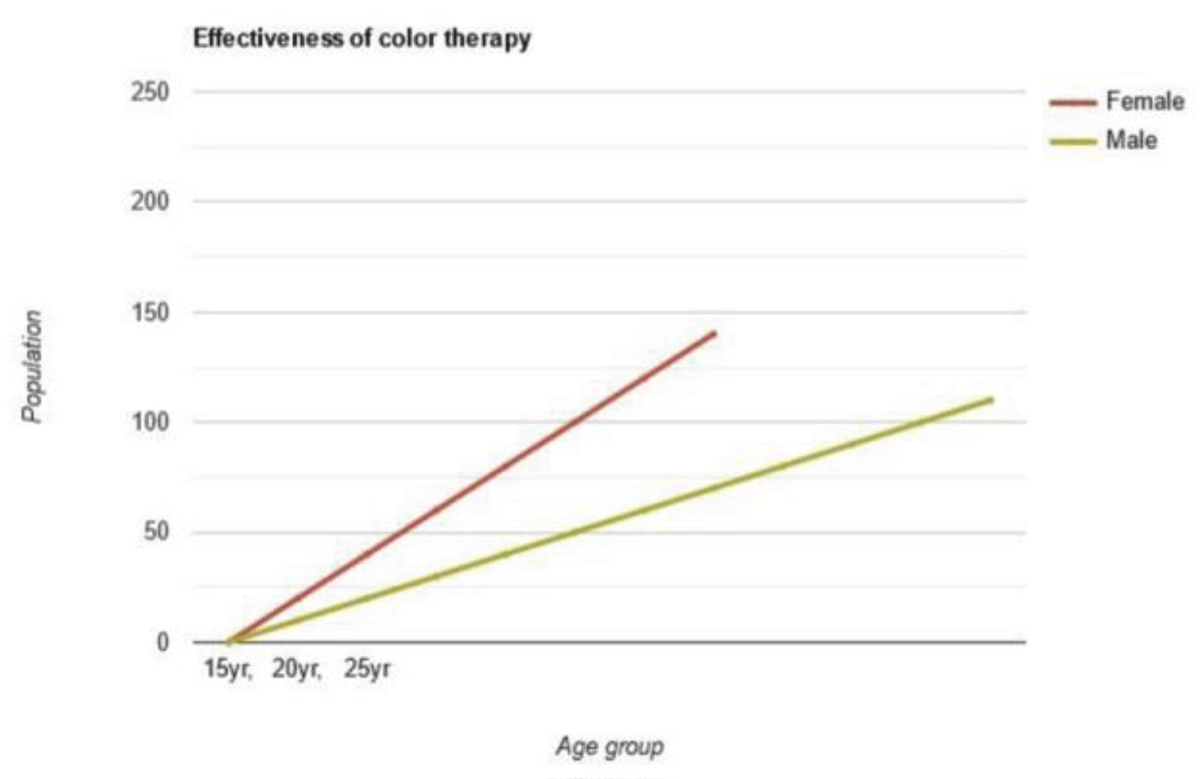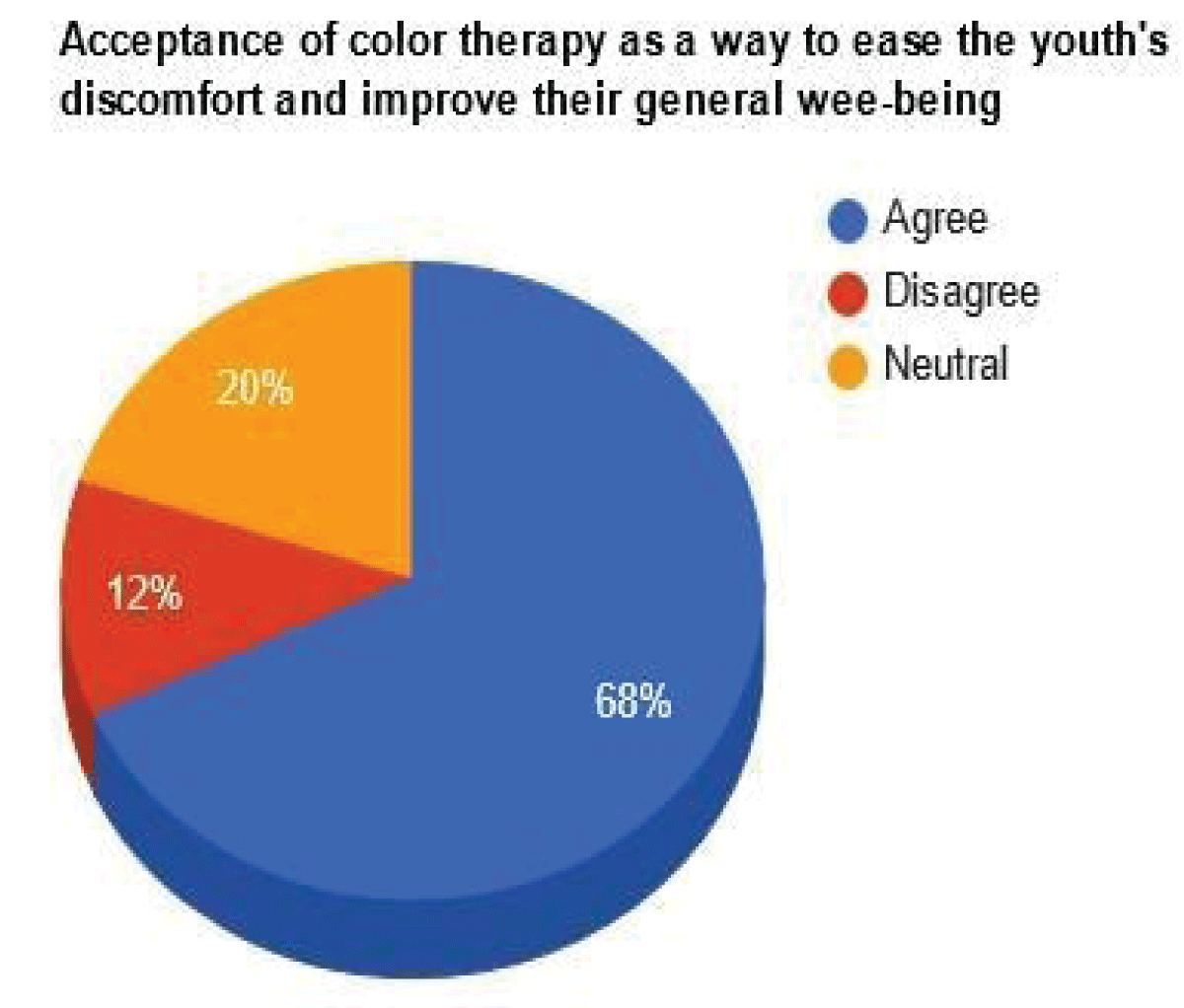More Information
Submitted: July 06, 2023 | Approved: September 22, 2023 | Published: September 25, 2023
How to cite this article: Acharjee K. The Effectiveness of Chromotherapy on Youth. J Forensic Sci Res. 2023; 7: 049-054.
DOI: 10.29328/journal.jfsr.1001049
Copyright License: © 2023 Acharjee K. This is an open access article distributed under the Creative Commons Attribution License, which permits unrestricted use, distribution, and reproduction in any medium, provided the original work is properly cited.
Keywords: Alternative therapy; Colored lights; Health improvement; Mental health; Treatment; Influence behavior; Healing abilities; Psychology
The Effectiveness of Chromotherapy on Youth
Kriticka Acharjee*
Graden City University, India
*Address for Correspondence: Kriticka Acharjee, Graden City University, India, Email: [email protected]
The majority of people view color therapy as an alternative therapy. It is a rather young field of study. There are a tonne of various elements in life that might affect your mood and mental health. It is proposed that colors and colored lighting can improve one’s physical or mental health. If you want to create a calm and clear workplace, it’s critical to understand how color influences your mood. The interaction between the human body and colors has been thoroughly explored in a variety of research. Despite the fact that color therapy has been used for thousands of years, people’s interest in it has grown more recently. Different body parts are related to different colors. These are the various energy centers’ inherent healing abilities. In today’s age of globalization, color therapy is one of the most well-liked complementary treatments used to affect people’s conduct and brains. In forensic psychology, color is a crucial element that helps to build our surroundings. Without color, our world would be lifeless and sad. It is essential to our built environment, especially for teenagers, people who are partially blind, adolescents, and those who, for one reason or another, feel confined and dissatisfied with their way of life. Our brains are programmed to focus on things that stand out from our surroundings in terms of color. Which qualities and traits we associate with a person are influenced by the color of her clothing. Depending on the context, it may be culturally prejudiced due to political movements or historical occurrences. This review clarified the significance of this therapy and its advancement in the field of psychology, raised awareness among today’s youth, and added a fresh perspective to this investigation.
The goal of color healing research is to cure sickness by restoring the body’s normal balance of color energy. It established that specific parts of the body respond to specific colors. The use of color therapy is non-invasive. In its simplest form, color therapy is the use of hues to ease emotional distress and even pain [1]. Each of us has a favorite color or a few shades that make us feel good. All of these are fantastic color selections that significantly improve either your mental or physical wellness. Already the Egyptians, Greeks, Chinese, and Indians have made use of Color therapy xx years ago. Colors were used to describe feelings and emotions. Because color has a strong physical component, it is fundamental to healing, which involves restoring balance. As modern healthcare experts incorporate color therapy into their practices as a complementary treatment, the curiosity about how color can aid in curing our bodies and brains continues. Color therapy is a mental health practice that is founded on the idea that people react differently to various hues [2]. Colors can affect a person’s energy level, mood, hunger, emotions, and even decision-making. While some colors are regarded to be energizing, others could be something both Goldsmiths in London.
For instance, a red-blue flashing stimulus stimulates the cortex more than a red-green or blue-green stimulus would [3]. It has been hypothesized (but not yet proven) that color therapy can improve blood pressure, hyperactivity disorder, learning disabilities, aggressive/hostile behavior, blood pressure, insomnia, lethargy, migraines, prison reform, stress, muscle relaxation, and vision disorders [4]. Color psychology is centered on the mental and emotional effects that colors have on sighted individuals in all aspects of their lives [5]. Color psychology includes some extremely subjective factors as well as some more acknowledged and confirmed elements. Keep in mind that there will be differences in interpretation, meaning, and perception among cultures [6]. Color therapy can assist you in exploring the traumatic and emotional blockages that have kept you from going there in the past [7]. But how it truly functions is that our brains translate light waves of various durations and frequencies to create the impression of color. There are thoughts, feelings, and numbers that correspond to these light waves. Each one vibrates with a distinct bond width [8]. Your subconscious mind is always drawn to a color whether you are working with it or are attracted to it. Colors influence us on all levels physical, mental, and emotional [9].
In theory, a mental health professional may utilize color therapy as a technique to understand the mental processes that influence behavior. The practice of color therapy, which mostly revolves around learning which colors make us feel better when we’re in need, can be discovered in this way as an introduction [10] One of the most effective traditional practices is currently attracting recognition as a legitimate and useful science [11]. Today, the majority of people view color therapy as a supplementary and alternative medicine treatment. According to science, different colors have different psychological effects:
- Red- It is believed to be a strong color with the ability to energize the body, stimulate the body, and boost heart rate and circulation.
- Orange- It frequently evokes feelings of happiness and optimism. The color may inspire fervor and passion while encouraging vigor and inventiveness.
- Yellow- It is often regarded as a cheery and bright color. Yellow is connected with the sun and light, which can assist in improving mood, sharpening focus, and maintaining a sense of tranquility.
- Green- Since it has relaxing and energizing effects, it is generally recognized for its restorative properties. Green colors with a natural feel may improve focus, productivity, and creativity.
- Blue- It is frequently seen as a calming color that helps ease anxiety, promote relaxation, and promote reflection.
- White- White is frequently associated with clarity and purity. It can bring harmony to the emotions and equilibrium to the body [12].
According to science, staring at colors can help you relax. That’s correct, colors have a huge psychological, emotional, and even bodily impact on us. Youth, like adults, have different personalities and soul-pleasing colors [13]. This indicates that some boisterous, active kids enjoy playing in a space with lots of color. However, it might not be what they require in a learning setting. It can be a good idea to scale back the vibrant hues they request in favor of milder variations. Ideal color schemes for work or study spaces would be more subdued hues. Children who are less active or more sensitive may always be drawn to softer, gentler colors, but in a school environment, they may need cleaner, sharper colors to stimulate them. Grey is not suggested because it is an unfocused color. It lacks judgment and is neutral [14]. Each color contains a distinct wavelength and frequency, according to scientific evidence, which affects our emotional and physical reactions. When we look at a particular color, our brains send signals to various parts of the brain that are involved in emotions, memory, and other processes. The way these signals interact with the brain can be used to explain how colors affect mood and feelings. For instance, it has been discovered that exposure to particular colors raises serotonin levels in the body, enhancing mood and lowering stress. Other colors have also been discovered to influence heart rate, control the neurological system, and change breathing patterns [15]. The potential advantages of chromotherapy are being further supported by the growing body of knowledge about the influence of color. The emotions and general health are improved by the vibrations of the color in color therapy [16]. Our cultural upbringing is what gives colors and their emotional connotations meaning. They differ between cultures. You are yellow (gelb vor Neid sein) in German while you are green with envy in English. Purple is frequently linked to luxury, aristocracy, and nobility. Purple, however, is the color of sorrow in Thailand and Brazil. Additionally, depending on the circumstance, there may be variations within a culture. Red can signify violence and unfairness during a football game (a red card) or passion at a flower store (red roses) [15]. Colors have some impacts that cross cultural boundaries. Higher arousal emotions like love, passion, happiness, and fury are evoked by warm colors like red, yellow, and orange. Cool hues like blue, green, and purple are associated with peace, melancholy, and indifference [17].
As far as the psychological effects of colors are concerned, we have come to know that colors are really beneficial for man in every respect [17]. Previous studies conducted in this regard have proven the fact that there is a specific color for each organ that affects the human body by producing physiological and/ or psychological effects if the specific organ is concerned, a low energy level [18].
Objective
To examine the efficiency of color therapy in the treatment of youth mental health and to understand youth emotions and moods. Explore the way color affects youth’s behaviors as well as chromotherapy’s potential to relieve youth people’s discomfort (such as stress and anxiety) and enhance their general welfare.
Materials and methods
Both primary and secondary data were used to inform this investigation. Through the many periods of life, we are affected by a cycle of shifting colors. Our shifting color preferences are a result of them. (Since chromotherapy can be used to enhance a person’s mental state, it can be combined with cognitive behavioral therapy, which aids youths in recognizing and altering negative thoughts and behaviors. Additionally useful for managing aggression, tension, anxiety, and criminal thought patterns [5].
Youth between the ages of 15 and 25 were used to gather the samples needed for the study. A specialized questionnaire was created, with a total of 25 questions, focusing on their favorite color and reason for it (before learning chromotherapy), how people generally perceive and believe about chromo treatment, the methods utilized, its prevalence, and its effectiveness. Based on their understanding, the data were gathered.
Additionally, color charts based on their moods were presented, and their feelings toward those colors were noted. Their areas of concern were focused when they completed the survey, and it was ensured that they would learn about this therapy and apply it to their daily lives [19].
Data analysis
The current study findings are developed and graphically represented using a table chart (Figure 1), line graphs (Figures 2,7), bar graphs (Figures 4,6) and pie charts (Figures 3,5,8). These charts are used to express parameters such as general awareness about chromo treatment, effectiveness, and youth acceptability of these methods.
Figure 1: Understanding of chromotherapy.
Figure 2: Colours have an impact on mood.
Figure 3: Colors can be used to express youth.
Figure 4: Colors can make you feel better.
Figure 5: Youths experience emotions through colours.
Figure 6: Youth behaviour can be influenced by colours.
Figure 7: The efficacy of colour therapy.
Figure 8: Acceptance of color therapy as a way to ease youths’ discomfort (i.e., stress) and enhance their general well-being.
Therapeutic value of colors that were applied in the study
The way that each individual perceives color might vary depending on their own mental and physical state. It’s crucial to keep in mind that no two people will react to a certain color in the same manner. So, the various colors have their physiologic and psychological impacts and table specification based on stress, anxiety, build, etc. (Table 1) [7].
| Table 1: Therapeutic Colors. | |||
| Sl.No. | Therapeutic Colors | Keynotes | |
| 1. | Red | • Consciousness of physical body • Use red to balance. | |
| 2. | Orange | • Eradicate the emotional scars (i.e., abuse, traumatic incident). | |
| 3. | Yellow |
|
|
| 4. | Green | • It is associated with the air element and the sense of touch. | |
| 5. | Indigo | • | It receives commands or guidance from the higher self. |
| • | Such people are introverted worrisome and anti-social | ||
| 6. | Blue |
• | An introverted individual whose aim is to keep peace. |
| • | Mainly they repress what they need to verbalize and often surrender. | ||
| 7. | Violet | • | Underdeveloped individuals may have little or no self-love |
| • | They going through a time of deep grief. | ||
In this study, 250 youths filled out a chromotherapy questionnaire survey form. Before learning about chromotherapy, where the youths were asked which colors they preferred and why, it became clear that their preferences were based on their mood, feelings, and views on life (Table 2) [5].
| Table 2: Prior to studying therapeutic colors, certain colors were preferred by youths. | ||
| SL.No. |
Colors preferred by Youths | Reasons |
| 1. | Black | Feels serene, alluring, and attractive, and expresses personality, happy and sad at the same time. |
| 2. | Blue | Calmness, and stability, symbolize wisdom, energy, refresherness, and expression of emotions. |
| 3. | White | Royal, peaceful, pleasant, vibrant, attractive, soothing intense. |
| 4. | Red | Bright, happy, grab attention, classy, shining. |
| 5. | Yellow | Joy, colorful, vibe, pleasant, moody, hopeful, happiness. |
| 6. | Violet/Purple | Refreshing, soothing, peaceful, soft, intense. |
| 7. | Green | Evergreen, gentle, positive, peaceful, silent, energized. |
In the current analysis, out of 250 people, 50% (150/250) know about chromo therapy, 48.5% believe color may impact their mood (121/250), (Figures 2,3), and 59.7% believe color can improve thought process (149/250), (Figure 4). Then, 78% (195/250) discovered that therapeutic colors convey and evoke feelings in them (170/250), (Figure 5) while 89% believe it is an effective treatment to some level (Figure 8). People responded positively to therapeutic colors making them feel better (Figure 4). In addition, 80% (200/250) of youths embrace chromotherapy as an alternative and effective way (Figure 8) to improve well-being. Colors can influence behavior. Red is an angry and aggressive color that indicates anger problems (90/250). Grey depicts depression and anxiety (50/250) (Figure 6).
Each color complements one of the spectral colors shown below, and color therapy can restore the appropriate balance of the chakras’ energy [5].
1. Vertex Chakra (Violet) - This symbol represents wisdom and spiritual vitality.
2. Forehead Chakra (Indigo) - Stand for intuition.
3. Larynx Chakra (Blue) - This represents creativity, communication, and language.
4. Heart Chakra (Green) - Stand for compassion, love, and peace.
5. Solar Plexus Chakra (Yellow) - Stands for intelligence and knowledge.
6. Spleen Chakra (Orange) - Signifies energy.
7. Basis Chakra (Red) - Stands for life and reproduction, i.e., influence sexual glands. While the idea of color therapy is that different colors provoke different feelings in different people, this isn’t always the case [20]. Humans are one-of-a-kind. Certain colors have different effects on different people. Colors that most people find tranquil or soothing may cause anxiety or depression in others [22]. The goal of the previous study was to popularise color therapy, and the compelling evidence supporting chromotherapy has elevated it to the status of one of the most potent and successful complementary and alternative medicine therapies [22]. The problem is that not many of us are aware of its advantages. While this study aims to aid youths, it has recently come to light that they frequently struggle with stress, behavioral problems, depression, etc. Additionally, learning about this alternate approach will encourage youths to recover from challenging circumstances [23-37].
Numerous research have discovered differences in color preferences across age, gender, and culture. The majority of the evidence implies that color preferences differ with age. A recent study has highlighted its benefits for a variety of ailments [5]. This graphical study will aid in understanding what is going through the minds of youths, as many of them struggle to express themselves effectively, leading them to experience feelings of insecurity, stress, and other negative emotions. Diverse colors have diverse properties that improve youths’ perspectives and feelings.
According to knowledge from popular culture, color can cause a variety of distinct reactions in people. Due to colors’ potent radiating influence on the entire body, using them in visualization is both most effective and simple for beginners. Regardless of the method employed, color therapy is a potent tool for fostering holistic wellness because it enables us to draw on our individual relationships with color. We may be able to use these strategies to restore harmony and balance to our lives by becoming aware of how various colors might impact our emotions and physical well-being.
Color is powerful in many facets of life. Our life cycle spans color conceptually and perceptually from birth to death. We become aware of things because we perceive and encounter them. The dawn brings with it vibrant colors in the outdoors with a variety of tones and tints. We use our favorite and most appropriate colors to design our personal items. However, each color has its unique meaning when used therapeutically. Colors can have extremely varied effects on emotions and behavior. Colors have some impacts that cross cultural boundaries. Higher arousal emotions like love, passion, happiness, and fury are evoked by warm colors like red, yellow, and orange. Cool hues like blue, green, and purple are associated with peace, melancholy, and indifference. These levels of stimulation and emotions can be evoked by colors. Numerous studies demonstrate the influence of the paint color. Therefore, chromotherapy can help to explain a person’s mental state, personality, and behavior. As a result, every color has a unique emotional and physical impact. Their effective use can boost productivity and induce relaxation throughout the body. The qualities and traits we associate with a person depend on the color of their clothing. Depending on the context, it could be culturally prejudiced due to political movements or historical occurrences. Chromotherapy is one of the most successful and potent supplemental and alternative treatment alternatives as a result of these compelling facts about it. The problem is that not many of us are aware of its advantages.
Future scope
In order for this strategy to be able to face the “challenge of the validity,” we must connect our methods with psychology and utilize color to research and understand the depth of teenagers and young people’s feelings as well as their behavior. Such a great coping method. For this method, we must research in the field of psychology- systems, practices, experiences, and methods outside of the laboratory and in their regional settings.
In conclusion, this study shows that blood serum pattern formation was distinctly altered by increased humidity in drying drops of blood on glass or skin. In addition, these data document that high humidity conditions were sufficient to confer transfer ability on previously dried blood, maintaining the original bloodstain pattern.
- IANS (2020) Healing through colors. E times.
- Rakesh G. Color therapy in mental health and well-being. 2021.
- Ohwovoriole T. Color Therapy: Types, Techniques and Benefits. 2023. https://www.verywellmind.com/color-therapy-definition-types-techniques-and-efficacy5194910
- Cherry K. Color Psychology: Does It Affect How You Feel?. verywell mind. 2022.
- Azeemi ST, Raza SM. A critical analysis of chromotherapy and its scientific evolution. Evid Based Complement Alternat Med. 2005 Dec;2(4):481-8. doi: 10.1093/ecam/neh137. PMID: 16322805; PMCID: PMC1297510.
- Anonymous. (2017). Color Therapy & Healing – An Introduction. http://www.arttherapyblog.com/online/color-therapy-healing-an-introduction/. [Art therapy Blog].
- Penni (2012) Magic of color. [Devine-space]. [Book].
- Gull S, Nadeem RK, Aslam A. Chromo therapy- An Effective Treatment Option or Just a Myth? Critical Analysis on the Effectiveness of Chromo therapy. 2015. 1. https://elenaarsenoglou.com/critical-analysiseffectiveness-chromo-therapy/ [American research journal of pharmacy]. [Research gate].
- Mantell M. Color Psychology: How Color Affects Your Emotions and Why. https://www.scienceofpeople.com/color-psychology/.
- Babbitt E. Principles of Light and Color. Kessinger Publishing. 1942.
- Psychological properties of colors. http://www.color-affects.co.uk/psychologicalproperties-of-colors
- Graham H. Discover Color therapy. Ca USA: Ulysses Press. (1998). 2004;
- Amber BR. Color Therapy. Aurora Press. [Google Scholar].1964.
- Cocilovo A. Colored light therapy: overview of its history, theory, recent developments and clinical applications combined with acupuncture. Am J Acupunct. 1999;27(1-2):71-83. PMID: 10513100.
- Vetter C. The effects of color on behaviour. 2019.
- Tappe NA. Understanding your life through color. USA, Aquila Libris. Publishing company. 2009.
- Amrapali Mahadev J. Color therapy in mental health and well-being. www.ijcrt.org. 2022.
- Anonymous (2018) Color Psychology: The Emotional Effects of Colors. http://www.arttherapyblog.com/online/color-psychology-psychologica-effects-of-colors/ [Art therapy Blog].
- Boyatzis CJ, Varghese R. Children's emotional associations with colors. J Genet Psychol. 1994 Mar;155(1):77-85. doi: 10.1080/00221325.1994.9914760. PMID: 8021626.
- Carruthers HR, Morris J, Tarrier N, Whorwell PJ. The Manchester Color Wheel: development of a novel way of identifying color choice and its validation in healthy, anxious and depressed individuals. BMC Med Res Methodol. 2010 Feb 9;10:12. doi: 10.1186/1471-2288-10-12. PMID: 20144203; PMCID: PMC2829580.
- Weller L, Livingston R. Effect of color of questionnaire on emotional responses. J Gen Psychol. 1988 Oct;115(4):433-40. doi: 10.1080/00221309.1988.9710580. PMID: 3210003.
- Perry R. Scientific documentation on color therapy. http://www.rachelperry.net/SCIENTIFIC.html.
- Charles K. Color Medicine the Secrets of Color/Vibrational Healing. USA. 1992. [Light Technology Publishing].
- Hankey A, Ewing E. New light on chromotherapy: Grakov's 'Virtual Scanning' system of medical assessment and treatment. Evid Based Complement Alternat Med. 2007 Jun;4(2):139-44. doi: 10.1093/ecam/nel060. Epub 2006 Oct 5. PMID: 17549230; PMCID: PMC1876617.
- Salazar LR. Exploring the effect of coloring Mandals on students math anxiety. 2019.
- Kaiser PK. Physiological response to color: A critical review. Color research & application. 1984; 9(1): 29-36.
- Birren F. Color psychology and color therapy; a factual study of the influence of color on human life. 2016.
- Wills P. Color healing manual: The complete color therapy programme revised edition. Singing Dragon. 2013.
- Yu C, Yoon H. The role of color in ‘health and wellbeing ‘of the built environment. 2010.
- Milford F. Color Therapy Using Tuning Forks. 2009.
- Kurt S, Osueke KK. The effects of color on the moods of college students. 2014.
- Wills P. Color Therapy: An Introductory Guide to the Healing Power of Color. 2016.
- O’ Connor Z. Color psychology and color therapy: Caveat emptor, color Research and Application. 2011. 36(3): 229 – 234. DOI:10.1002/col.20597 [Research gate].
- Pleasanton A. Blue and Sun Light. Philadelphia: Claxton.
- Okuno T, Saito H, Ojima J. Evaluation of blue-light hazards from various light sources. Dev Ophthalmol. 2002;35:104-12. doi: 10.1159/000060814. PMID: 12061267.
- von JGW. The Theory of Colors. The M.I.T. Press, London. 2000.
- Vazquez R. The New Process Color Theory.
